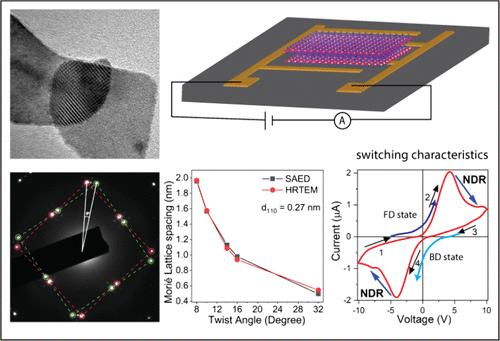非范德华双分子层Bi2O2Se中moir超晶格和记忆开关的研究
IF 8.2
2区 材料科学
Q1 MATERIALS SCIENCE, MULTIDISCIPLINARY
引用次数: 0
摘要
二维(2D)材料中波纹物理的发现为探索层内/层间相互作用引起的独特物理和化学性质开辟了新的途径。本文报道了通过一锅化学反应方法和超声辅助层分离技术生长的二维氧化硒化铋(Bi2O2Se)纳米片的波纹图案的实验观察。我们的研究结果表明,这些莫尔条纹图案是由纳米片以不同的扭曲角度堆叠而成的,导致形成具有不同周期性的莫尔条纹超晶格(MSLs)。利用透射电子显微镜(TEM)图像证实了这些超晶格的存在。在二维Bi2O2Se纳米片上观察到的moirir模式强调了调整非范德华材料的带结构的潜力,从而通过精确控制层内/层间相互作用来解锁新的材料特性。此外,堆叠的二维Bi2O2Se纳米片显示出有趣的忆阻开关特性,为人工突触和神经形态计算提供了一个有希望的候选材料。传统的忆阻器通常采用垂直金属-绝缘体-金属(MIM)结构,该结构依赖于电阻开关(RS)的导电丝的形成。然而,这种配置通常会导致在不同的周期中突然切换,并且设备之间的差异很大。本研究中,缺陷BOSe moir本文章由计算机程序翻译,如有差异,请以英文原文为准。

Exploring Moiré Superlattices and Memristive Switching in Non-van der Waals Twisted Bilayer Bi2O2Se
The discovery of moiré physics in two-dimensional (2D) materials has opened new avenues for exploring unique physical and chemical properties induced by intralayer/interlayer interactions. This study reports the experimental observation of moiré patterns in 2D bismuth oxyselenide (Bi2O2Se) nanosheets grown through one-pot chemical reaction methods and a sonication-assisted layer separations technique. Our findings demonstrate that these moiré patterns result from the angular stacking of the nanosheets at various twist angles, leading to the formation of moiré superlattices (MSLs) with distinct periodicities. The presence of these superlattices was confirmed using transmission electron microscopy (TEM) images. The observation of moiré patterns in 2D Bi2O2Se nanosheets highlights the potential of tuning the band structures of the non-van der Waals material and thus unlocking new material properties through precise control of intralayer/interlayer interactions. Furthermore, the stacked 2D Bi2O2Se nanosheets show interesting memristive switching characteristics, presenting a promising candidate for artificial synapses and neuromorphic computing. Traditional memristors typically utilize a vertical metal–insulator–metal (MIM) structure, which relies on the formation of conductive filaments for resistive switching (RS). This configuration, however, often results in abrupt switching during various cycles and significant variation from device to device. Herein, defective BOSe moiré material exhibits a nonfilamentary RS switching characteristic in a two-terminal lateral device configuration. This design reveals an RS mechanism driven by the modulation of the Schottky barrier height (SBH) due to the movement of Se vacancies (VSe) under an external electric field. The fabricated device exhibits excellent RS behavior, achieving an RS ratio of ∼20 with a high degree of control and consistency across multiple cycles and from device to device. Interestingly, the device shows a stable negative differential resistance effect in the high-voltage region due to the carrier trapping process. Finally, we studied the stability of the MSL in BOSe through TEM imaging and electrical characterization on different device configurations to evaluate the repeatability of the switching characteristics.
求助全文
通过发布文献求助,成功后即可免费获取论文全文。
去求助
来源期刊

ACS Applied Materials & Interfaces
工程技术-材料科学:综合
CiteScore
16.00
自引率
6.30%
发文量
4978
审稿时长
1.8 months
期刊介绍:
ACS Applied Materials & Interfaces is a leading interdisciplinary journal that brings together chemists, engineers, physicists, and biologists to explore the development and utilization of newly-discovered materials and interfacial processes for specific applications. Our journal has experienced remarkable growth since its establishment in 2009, both in terms of the number of articles published and the impact of the research showcased. We are proud to foster a truly global community, with the majority of published articles originating from outside the United States, reflecting the rapid growth of applied research worldwide.
 求助内容:
求助内容: 应助结果提醒方式:
应助结果提醒方式:


